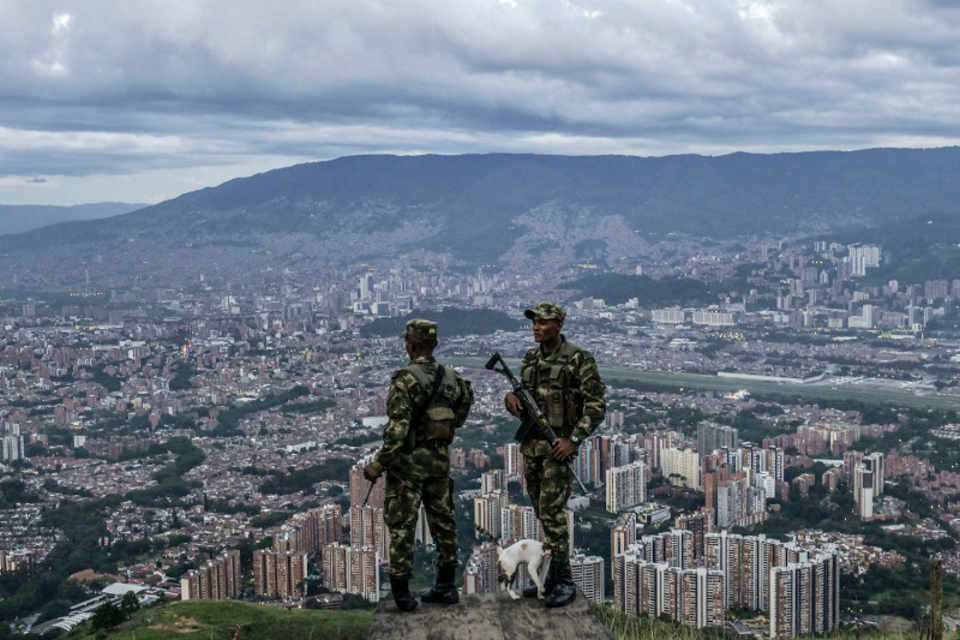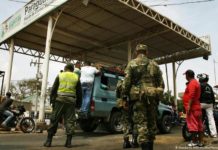As Venezuela’s Russia-backed leader Nicholás Maduro continues to cling to power, the U.S. military wants to prevent a crisis from spilling over into neighboring Colombia, an important ally, by beefing up its defenses.

The U.S. Air Force is offering Bogotá the latest version of Lockheed Martin’s F-16 fighter jets, Maj. Gen. Andrew Croft, the commander of Air Forces Southern, told Foreign Policy in a recent phone interview.
The addition of an estimated 15 F-16 to Colombia’s arsenal would “be a great advancement for not only their capability to defend their sovereign air space” but would also help enable interoperability with U.S. forces, Croft said during a visit to Colombia, where he attended a major air show and met with senior Colombian military officials.
Venezuela’s economy has collapsed under Maduro’s far-left government, and nationwide electricity blackouts and food shortages have plagued the country’s population. But opposition leader Juan Guaidó has failed to take power despite repeated violent clashes between government forces and civilians.
Now, U.S. officials are worried that the upheaval could threaten Colombia. Maduro, whose government is backed by U.S. rivals China, Russia, and Cuba, is an unpredictable neighbor armed with roughly 150,000 troops and both Russian and U.S. equipment, including advanced fighter jets. In addition, dangerous rebel groups—both Colombia’s National Liberation Army and factions of the Revolutionary Armed Forces of Colombia (FARC)—are taking advantage of the crisis to expand their reach. These armed groups are targeting Venezuelans fleeing their home country, offering them food and pay in return for joining their ranks.
“The conditions in Venezuela, the same chronic conditions that have just created abject suffering for the Venezuelan people, have created a lawless zone,” U.S. Navy Adm. Craig Faller, the chief of U.S. Southern Command, told Foreign Policy in April.
Buying new F-16s, a supersonic fighter jet with advanced radar and extended range, would not only deter threats from Venezuela and armed rebel groups but also provide a better capability to intercept narcotraffickers, who are beginning to use fast Learjets to smuggle drugs in and out of the country, Croft said.
“All bets are off, right? You don’t know what’s going to happen,” said Richard Aboulafia, an analyst with the Teal Group, explaining the renewed push to sell Colombia advanced fighter jets. “Is it a proxy fight? Is it Venezuela lashing out? Is it some other kind of conflict spillover because of the refugee situation? There are all kinds of scenarios.”
The United States has a long and deep military relationship with Colombia, including frequent exercises, officer exchange programs, and visits by senior military leaders. Particularly since 2016, when the Colombian government signed a peace accord with the FARC, ending more than half a century of conflict, the U.S. military has made a concerted effort to support the country’s efforts at security, including arms sales.
The U.S. government frequently uses foreign military sales as a diplomatic tool. The F-35, Lockheed’s most sophisticated fighter jet, is the most prominent example: In addition to the United States, 12 allied nations have plans to operate the plane, boosting not only Lockheed’s top line but also U.S. influence around the globe. These types of agreements typically come with U.S. training, maintenance support, and close security ties for decades after the ink dries.
The United States also uses these types of deals to pressure allies and potential adversaries. The Pentagon this week booted Turkey out of the F-35 program over its purchase of a Russian-made missile defense system, a decision that will cost Turkish industry $9 billion in projected work and damage Ankara’s standing in NATO. In the Pacific, the administration is looking to sell Taiwan 66 new F-16s, a significant provocation of China as the world’s two largest economies agree to restart trade talks.
“Anytime we do a foreign military sale program with a nation, especially an airframe, it gives us a 40- to 50-year relationship,” Croft said.
If Colombia chooses to buy them, the F-16s would replace its fleet of 21 aging Israeli Kfir jets that are reaching the end of their usable lives. But the costly U.S. jet faces steep competition: The Swedish defense firm Saab is offering its Gripen fighters as a possible replacement, while Europe’s Eurofighter has proposed its Typhoon jets. Bogotá has also considered buying surplus older F-16s from the Israeli Air Force.
The F-16 offering has been in the cards for a while but “could get new impetus because of Venezuela, because of what Venezuela has been up to,” said Byron Callan, an analyst with Capital Alpha Group.
The United States has sold F-16s to Colombia’s neighbors, including Chile and, ironically, Venezuela. Venezuela also operates Russian Su-30 fighter jets, which Croft said are “a threat to the region.”
Clinching an F-16 sale with Colombia would also come with an added bonus—taking a potential business opportunity away from Russia or China, both of which are quietly trying to grow their influence in Latin America through foreign military sales, disinformation campaigns, and economic investment.
“Selling something like an F-16 to a nation like Colombia builds that long-term relationship and also prevents the Russians or the Chinese from selling them a system that then becomes very difficult or impossible to maintain,” Croft said.
The United States is particularly worried about China’s practice of “debt diplomacy” throughout the region, including investing in infrastructure and providing hefty loans that impoverished nations will have difficulty paying back. China has also bought up key ports in the region and built a new deep-space ground station in Argentina, from which the Chinese military can monitor and potentially target U.S. and allied satellites.
“The Chinese side is all about lending money to these nations so they can do projects that are then run by Chinese companies and Chinese labor, and then the debt becomes a lever … things like port access, control of railroads and roads, and the like,” Croft said.
In order to counter China’s influence, the U.S. military is investing in key military-to-military partnerships, such as the one with Colombia. The strength of that partnership was on display during his visit, Croft stressed.
“These guys are our best partner, one of our strongest partners that we have in the region,” Croft said. “I’m not sure the relationship has ever been stronger than it’s been right now.”













